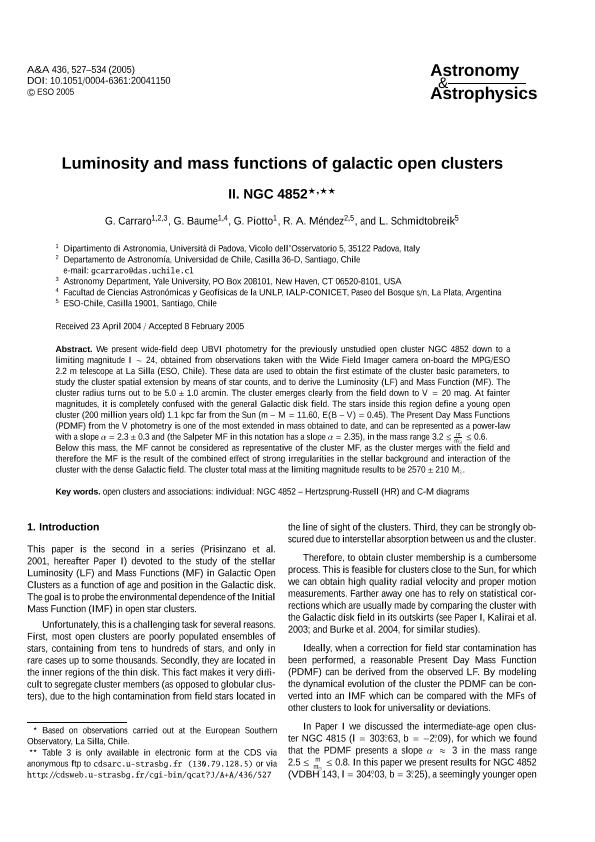Mostrar el registro sencillo del ítem
dc.contributor.author
Carraro, Giovanni

dc.contributor.author
Baume, Gustavo Luis

dc.contributor.author
Piotto, G.
dc.contributor.author
Méndez, R. A.
dc.contributor.author
Schmidtobreik, L.
dc.date.available
2018-03-15T14:44:25Z
dc.date.issued
2005-06
dc.identifier.citation
Carraro, Giovanni; Baume, Gustavo Luis; Piotto, G.; Méndez, R. A.; Schmidtobreik, L.; Luminosity and mass functions of galactic open clusters, II: NGC 4852; EDP Sciences; Astronomy and Astrophysics; 436; 2; 6-2005; 527-534
dc.identifier.issn
0004-6361
dc.identifier.uri
http://hdl.handle.net/11336/38875
dc.description.abstract
We present wide-field deep UBVI photometry for the previously unstudied open cluster NGC 4852 down to a limiting magnitude I ∼ 24, obtained from observations taken with the Wide Field Imager camera on-board the MPG/ESO 2.2 m telescope at La Silla (ESO, Chile). These data are used to obtain the first estimate of the cluster basic parameters, to study the cluster spatial extension by means of star counts, and to derive the Luminosity (LF) and Mass Function (MF). The cluster radius turns out to be 5.0 ±1.0 arcmin. The cluster emerges clearly from the field down to V = 20 mag. At fainter magnitudes, it is completely confused with the general Galactic disk field. The stars inside this region define a young open cluster (200 million years old) 1.1 kpc far from the Sun (m - M = 11.60, E(B - V) = 0.45). The Present Day Mass Functions (PDMF) from the V photometry is one of the most extended in mass obtained to date, and can be represented as a power-law with a slope α = 2.3 ± 0.3 and (the Salpeter MF in this notation has a slope α = 2.35), in the mass range 3.2 ≤ m/m⊙ ≤ 0.6. Below this mass, the MF cannot be considered as representative of the cluster MF, as the cluster merges with the field and therefore the MF is the result of the combined effect of strong irregularities in the stellar background and interaction of the cluster with the dense Galactic field. The cluster total mass at the limiting magnitude results to be 2570 ±210 M⊙. © ESO 2005.
dc.format
application/pdf
dc.language.iso
eng
dc.publisher
EDP Sciences

dc.rights
info:eu-repo/semantics/openAccess
dc.rights.uri
https://creativecommons.org/licenses/by-nc-sa/2.5/ar/
dc.subject
Star Clusters
dc.subject
Open Clusters
dc.subject
Ngc 4852 (Galaxia)
dc.subject
Cm Diagrams
dc.subject
Hertzsprung-Russell
dc.subject.classification
Astronomía

dc.subject.classification
Ciencias Físicas

dc.subject.classification
CIENCIAS NATURALES Y EXACTAS

dc.title
Luminosity and mass functions of galactic open clusters, II: NGC 4852
dc.type
info:eu-repo/semantics/article
dc.type
info:ar-repo/semantics/artículo
dc.type
info:eu-repo/semantics/publishedVersion
dc.date.updated
2018-03-06T15:10:49Z
dc.journal.volume
436
dc.journal.number
2
dc.journal.pagination
527-534
dc.journal.pais
Francia

dc.description.fil
Fil: Carraro, Giovanni. University of Yale; Estados Unidos. Università di Padova; Italia. Universidad de Chile; Chile
dc.description.fil
Fil: Baume, Gustavo Luis. Università di Padova; Italia. Universidad Nacional de La Plata. Facultad de Ciencias Astronómicas y Geofísicas; Argentina
dc.description.fil
Fil: Piotto, G.. Università di Padova; Italia
dc.description.fil
Fil: Méndez, R. A.. European Southern Observatory Santiago; Chile. Universidad de Chile; Chile
dc.description.fil
Fil: Schmidtobreik, L.. European Southern Observatory; Chile
dc.journal.title
Astronomy and Astrophysics

dc.relation.alternativeid
info:eu-repo/semantics/altIdentifier/doi/http://dx.doi.org/10.1051/0004-6361:20041150
dc.relation.alternativeid
info:eu-repo/semantics/altIdentifier/url/https://www.aanda.org/articles/aa/abs/2005/23/aa1150-04/aa1150-04.html
Archivos asociados
